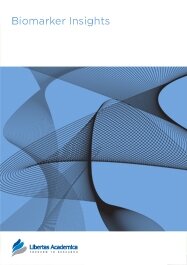

Publication Date: 14 Aug 2011
Type: Original Research
Journal: Biomarker Insights
Citation: Biomarker Insights 2011:6 83-93
doi: 10.4137/BMI.S7513

A widely held viewpoint in the field of predictive biomarkers for disease holds that no single marker can provide high enough discrimination and that a panel of markers, combined in some type of algorithm, will be needed. Motivated by a recent study where 27 additional markers for ovarian cancer, many of which had good predictive value alone, failed to substantially increase the predictive ability of the primary marker of CA125, we explore the effect of additional markers on the area under the ROC curve (AUC). We develop a statistical model based on the multivariate normal distribution and linear algorithms and use it to explore how the magnitude and direction of statistical correlation among the markers (in diseased and in non-diseased) is critical in determining the added predictive value of additional markers. We show mathematically and empirically that if the additional marker(s) is negatively correlated with the primary marker, then it will always be able to provide increased AUC when combined with the primary marker (as compared to that obtained with the primary marker alone), even if it has little predictive ability on its own. In contrast, if the additional marker(s) is positively correlated with the primary marker, then it is unlikely to substantially increase the AUC when combined with the primary marker, even when it has good predictive ability on its own. Thus, univariate analyses alone may not be the best approach in choosing which markers to combine in a predictive panel of markers; patterns of statistical correlation should be considered in ranking top-performing biomarkers.
PDF (4.83 MB PDF FORMAT)
RIS citation (ENDNOTE, REFERENCE MANAGER, PROCITE, REFWORKS)
BibTex citation (BIBDESK, LATEX)
XML
PMC HTML


I have had a great experience with submitting my cancer prognosis study to Biomarker Insights. The comments from reviewers and associate editor are high quality and insightful. Congratulations and keep up the good work.

All authors are surveyed after their articles are published. Authors are asked to rate their experience in a variety of areas, and their responses help us to monitor our performance. Presented here are their responses in some key areas. No 'poor' or 'very poor' responses were received; these are represented in the 'other' category.See Our Results
Copyright © 2013 Libertas Academica Ltd (except open access articles and accompanying metadata and supplementary files.)
Facebook Google+ Twitter
Pinterest Tumblr YouTube